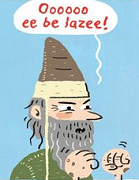stubblyhead posted:Definitely a Starling, and they are definitely very chattery birds. Also complete shits. I would love to hear more about rear end in a top hat birds.
|
|
|
|
|

|
| # ? Apr 19, 2024 22:33 |
|
Wooten posted:It wasn't cold and raining today, so I finally got a chance to go outside. Those are lightning bugs, aren't they? Lightning bugs are the best.
|
|
|
|
Neurion posted:I would love to hear more about rear end in a top hat birds. As its name would suggest, the European Starling is not native to the US. About 120 years ago or so some rich weirdo decided it would be awesome to introduce every bird mentioned in the works of Shakespeare to the US because obviously. He released something like 100 pairs of them in Central Park, and they're now one of the most prevalent bird species in America. I am not making this up. They're not especially aggressive or anything like that as individuals, but they do tend to compete very successfully with native species for nesting sites, and cause a pretty significant amount of crop damage. They're considered a nuisance species here and are one of very few birds not protected by the Migratory Bird Act. Local laws may differ, but as far as the feds are concerned its open season 365 days a year.
|
|
|
stubblyhead posted:As its name would suggest, the European Starling is not native to the US. About 120 years ago or so some rich weirdo decided it would be awesome to introduce every bird mentioned in the works of Shakespeare to the US because obviously. He released something like 100 pairs of them in Central Park, and they're now one of the most prevalent bird species in America. I am not making this up. They're not especially aggressive or anything like that as individuals, but they do tend to compete very successfully with native species for nesting sites, and cause a pretty significant amount of crop damage. They're considered a nuisance species here and are one of very few birds not protected by the Migratory Bird Act. Local laws may differ, but as far as the feds are concerned its open season 365 days a year. Ah yeah, I think I heard about this on QI. Don't they foul everything with their droppings?
|
|
|
|
|
Not that it contributes to their pest status or anything but I think starlings have these mating habits where males peck at a female's cloaca and irritates it so much that it convulses and ejects the sperm of the last bird(s) she mated with. So yeah, total fuckers. Edit: No wait, that's the dunnock. Still, starlings are assholes. Mak0rz fucked around with this message at 05:05 on May 9, 2014 |
|
|
|
Neurion posted:I would love to hear more about rear end in a top hat birds. They're very smart and social birds, in addition to being assholes. A former employer of mine used to run a starling rescue operation (because most animal shelters would just kill them, since they can't legally be released in the US), and once they had gotten used to being around humans they would watch us carefully and even learn sentence fragments. One of them pieced together the phrase "Sweet doin', baby!" from my boss telling it "Sweet baby Maya" (Maya was the bird's name) and "How ya doin'?" It then proceeded to teach that phrase to two of the other starlings. Since then, I've harbored a secret hope that one of them would escape and teach that phrase to a huge flock of starlings so that the countryside would be serenaded with calls of "Sweet doin' baby!"
|
|
|
|
AceClown posted:Look at this alien looking motherfucker, he's amazing. The alien looking spider is an Opilionid, aka Daddy long legs or harvestman. They're arachnids, but a separate order from spiders. The not-a-mayfly is an Alderfly, genus Sialis. They're in their own order, Megaloptera, but closely related to lacewings and antlions (Neuroptera). Alderflies have aquatic larvae, and never stray far from water.
|
|
|
|
AceClown posted:And a teeny tiny day flying moth, there were hundreds of these things around, it blows my mind that somewhere someone has catalogued all these and knows exactly what it is
|
|
|
|
i almost ran over a skunk the other night
|
|
|
|
Balaeniceps posted:Moths are surprisingly popular insects to study in the UK. We have some excellent literature available so you can ID species with the naked eye, and light trapping makes it an easy hobby. This moth is the Nettle Tap, Anthophila fabriciana - it's a dead-common day-flying species and the wing shape is quite distinctive. axolotl farmer posted:The alien looking spider is an Opilionid, aka Daddy long legs or harvestman. They're arachnids, but a separate order from spiders. Thanks guys, just really getting started on this whole bug hunt fun and I've actually joined the local wildlife trust and signed up for butterfly transect monitoring :3
|
|
|
|
AceClown posted:Thanks guys, just really getting started on this whole bug hunt fun and I've actually joined the local wildlife trust and signed up for butterfly transect monitoring :3 If you're in the UK, you really should get the field guides by Michael Chinery. Insects of Britain and Western Europe has pictures of nearly every common insect, and Insects of Britain and Northern Europe has keys to most families of insects that you can identify without specialized equipment.
|
|
|
|
Fffff alderflies/dobsonflies is the name for Megaloptera, stonefly is the name for Plecoptera. I need to stop loving up
|
|
|
|
T1g4h posted:Caught what i'm thinking is a European Starling while I was on break at work yesterday. Pretty sure there's a nest just above our shop, because I heard what sounded like a lot of babies and this one kept hanging out around the roof and gutters. I wish the sky hadn't been so grey and overcast but oh well Nice photos. I have a nest of starlings right outside my window, they nest in the gutters of this house every year. I didn't mind so much last year but now that I'm 'working from home'(aka unemployed) the chirping of the babies is slowly driving me insane. It's right above the front door too so when I'm coming in or out of the house I will often be greeted by one of the parent birds telling me to get the gently caress away from their nest. They are such pretty birds though, with all the speckles. And the adults make such a great variety of noises; chirps and burbles and chatters. I can't stay mad at them
|
|
|
|
Pick posted:Fffff alderflies/dobsonflies is the name for Megaloptera, stonefly is the name for Plecoptera. I need to stop loving up You were way closer on your guess than I was. v
|
|
|
|
axolotl farmer posted:If you're in the UK, you really should get the field guides by Michael Chinery. Insects of Britain and Western Europe has pictures of nearly every common insect, and Insects of Britain and Northern Europe has keys to most families of insects that you can identify without specialized equipment. There's also a new photographic guide by Paul Brock that is due out in a couple of weeks. The author put out an absolutely excellent guide to the Insects of the New Forest a couple of years ago so based off of that I've already pre-ordered it. Brock's been consulting most of the nation's experts for the various orders and it should cover more species than either Chinery book. On the other hand photographic guides can be both a blessing and a curse.
|
|
|
|
floofyscorp posted:Nice photos. I have a nest of starlings right outside my window, they nest in the gutters of this house every year. I didn't mind so much last year but now that I'm 'working from home'(aka unemployed) the chirping of the babies is slowly driving me insane. It's right above the front door too so when I'm coming in or out of the house I will often be greeted by one of the parent birds telling me to get the gently caress away from their nest. Hah, that's the only issue i've had with this lot so far. The nest is, from what I can tell, right above the door to our shop. Any time you want to go in or out, you run the risk of disturbing them and getting all kinds of mean looks. There also seem to be a group of house sparrows hanging out on the opposite end of the building, but they just tend to chirp and fly away more than anything 
|
|
|
|
Yay spring! All pictures taken in northeastern Kansas. Click for as much detail as I could manage to pull out of them. Went down to my favorite spot, and the family of Collared Lizards that live in the rocks there has some new members!  Collared Lizard by h. meadors, on Flickr  Collared Lizard by h. meadors, on Flickr 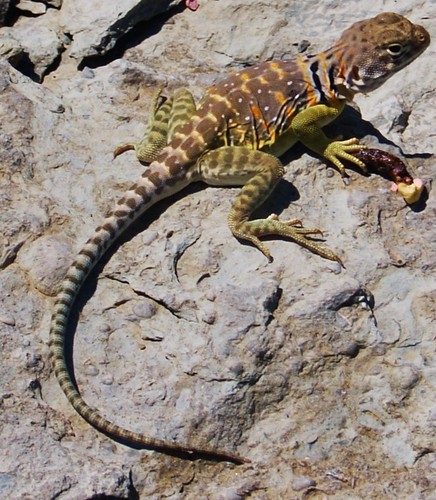 Collared Lizard by h. meadors, on Flickr 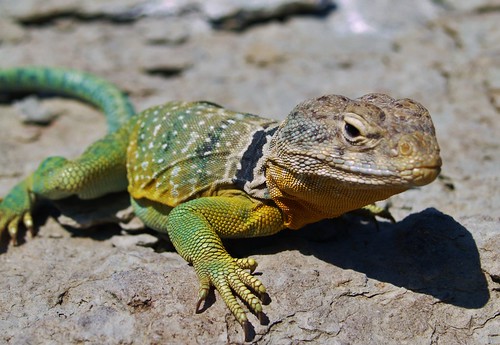 Collared Lizard by h. meadors, on Flickr  Collared Lizard by h. meadors, on Flickr 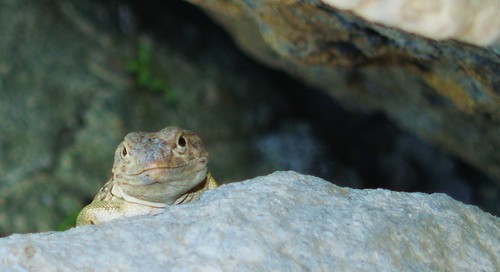 Collared Lizard by h. meadors, on Flickr 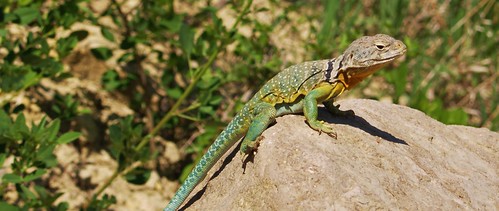 Collared Lizard by h. meadors, on Flickr I also managed to get close to a couple of Bullfrogs, one of whom was HUGE. 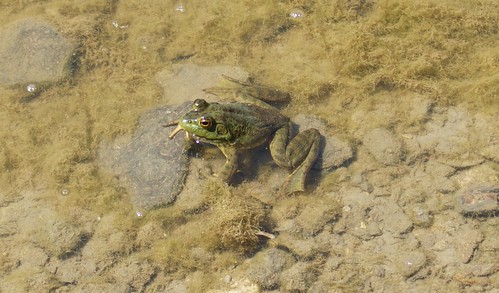 Bullfrog by h. meadors, on Flickr  Bullfrog by h. meadors, on Flickr And a....Water Snake?  Water Snake by h. meadors, on Flickr EDIT: Fixed the microscopic thumbnails. Jadz fucked around with this message at 03:08 on May 10, 2014 |
|
|
|
Jadz posted:Yay spring! All pictures taken in northeastern Kansas. Click for as much detail as I could manage to pull out of them. This might be a plain belly water snake? I'm basing that mostly on your location and the coloration. Serpentes Colubridae Natricinae Nerodia erythrogaster Love the photographs!
|
|
|
|
Suicide Sam E. posted:This might be a plain belly water snake? I'm basing that mostly on your location and the coloration. Yeah, that was the best ID I could come up with on my own, too, based on pictures from the Kansas Snake Guide and Google. Without being able to catch him and take a closer look, I can't be sure exactly what he is, but Plain Belly Water Snake seems as likely as anything lol Thanks  EDIT: vvvvvvvvvv Yeah, he was roughly two, two-and-a-half feet Jadz fucked around with this message at 03:27 on May 10, 2014 |
|
|
|
I'm pretty sure that that's a northern watersnake, but smaller plain bellies will have similar patterning - adults have a solid, dark patterning. The big thing is the belly - northerns still have a striped pattern, but erythrogaster have a solid colored belly, generally red, but yellow in other subspecies. So judging by the size (looks at least two feet?) and I think you can see parts of the underside on the snake (hard to tell), so I'd call that N. sipedon.
|
|
|
|
Forgive the blurriness, I was trying to get bee pictures and those fuckers move fast. So fast, in fact, that it wasn't until examining the photo later that I realized it wasn't a bee. IMG_2682 by Tjadenne, on Flickr Some kind of hummingbird moth, I think? I didn't know they came in bee-flavor.
|
|
|
|
Tjadeth posted:Forgive the blurriness, I was trying to get bee pictures and those fuckers move fast. So fast, in fact, that it wasn't until examining the photo later that I realized it wasn't a bee. They do indeed. That is a Snowberry Clearwing. Hemaris diffinis They aren't uncommon, if you stake out a good flower garden for a few minutes you'll spot one, but they look and fly so much like bumbles that you probably don't recognise them most of the time. http://bugguide.net/node/view/2639
|
|
|
|
Jadz posted:Yay spring! All pictures taken in northeastern Kansas. Click for as much detail as I could manage to pull out of them.
|
|
|
|
Knormal posted:Great collared lizard pics, can I ask the general area you took them? I've never been to Kansas but my impression of it is grasslands, pretty much the polar opposite of the open rocky desert areas I see collareds in here in the west, and I've always been curious about how the midwestern populations live. I want to look up the areas on Google Earth and see if there's secret boulder fields hiding there or something. Or if you have any scenery shots of the general area you see collareds in that would be even better. I live in Manhattan, Kansas, and these pictures were taken about a mile from my house at the Tuttle Creek Riverpond State Park. The area of northeastern Kansas that I live in is called the Flint Hills - there is a great deal of tallgrass prairie and farm land out here, but nearly every place that has a river or creek running through it is also chock-full of exposed flint, shale and limestone. The area in the pictures is the bank of a wide stream of run-off from a dam just to the north, which creates a couple of different habitats in a tiny little area. What starts out at the foot of the dam as tallgrass turns into about a football field-length marshland, then the water pools into a tiny frog pond which drains in a small stream that waterfalls over some short flint cliffs and into the deep, wide pool of run-off which connects to the larger fishing lake (note: not really a lake) across the road via a storm culvert. A google maps thing of the area looks like this: 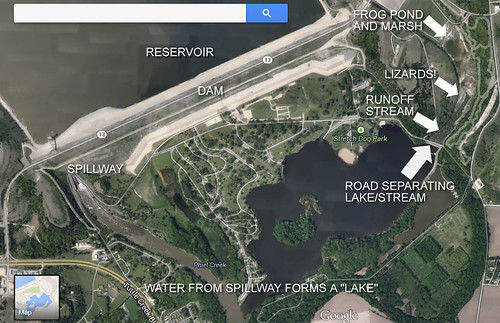 tuttle_map by h. meadors, on Flickr In person, the place looks like this: 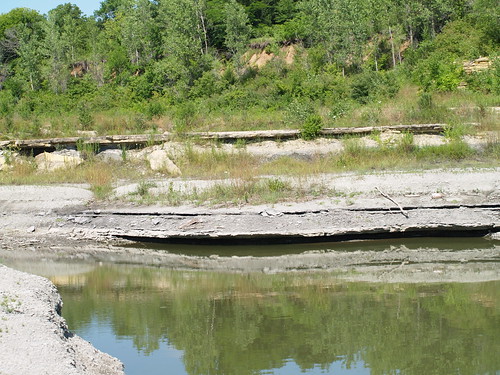 tuttle runoff by h. meadors, on Flickr This is my go-to area when I get a hankering to go take pictures of things. The lizards are fairly chill, and always sit and pose for a few pictures that usually turn out really well, as long as I don't make any sudden movements. This is also where the vast majority of the arthropod pictures in my Flickr feed come from. I love living here 
Jadz fucked around with this message at 17:36 on May 10, 2014 |
|
|
|
Jadz posted:I live in Manhattan, Kansas, and these pictures were taken about a mile from my house at the Tuttle Creek Riverpond State Park. The area of northeastern Kansas that I live in is called the Flint Hills - there is a great deal of tallgrass prairie and farm land out here, but nearly every place that has a river or creek running through it is also chock-full of exposed flint, shale and limestone.
|
|
|
|
Knormal posted:Wow, that is not where I'd have expected to find collared lizards at all, it's so developed. I wonder if having more available hiding places makes them more tolerant of living near people? The collareds I find out here are still cocky and will let me get close, but they always seem to live far away from permanent settlements where I think they see the occasional human wandering around more of a curiosity than a threat. EDIT: I think I get what you mean by "it's so developed" now. The park you're looking at in the Google thing is a state park - it's all nature trails and campgrounds. It's all very outdoorsy and apart from the stuff the Parks and Wildlife folks do, it's largely unmolested by people. There's an overlay on the map that shows all the paths and trails in the park, and it makes it look like a neighborhood or something, but yeah, the lizards are fairly removed from civilization. I've heard that a few times, about how weird it is that they're not only living where we get REALLY cold winters, but barely two miles from a decent-sized city. Honestly, I kind of wonder if they didn't get introduced here somehow and just managed to find a nice little niche here at the dam. I had read that they are often taken as pets because they do well in captivity and within a single generation of being born in captivity, they're perfectly comfortable with human interaction. Maybe someone had some as pets and then "let them go" or something. I've never seen them anywhere else in Kansas before I started seeing them here. Normally if I see a lizard in Kansas, it's a skink or a grass lizard or something super-common. From what I've read, they're found in very few places this far north - some here in Kansas, and some in parts of Missouri - they are usually found in southern/western Oklahoma and further south/west. Jadz fucked around with this message at 08:38 on May 11, 2014 |
|
|
|
The Canada Geese and Double-crested Cormorants at Lake Merritt in Oakland have hatchlings now https://www.youtube.com/watch?v=7bjpYUt3sUU https://www.youtube.com/watch?v=HSsBOzyMPks
|
|
|
|
So. What had to be a queen Dolichovespula maculata was hopping around various bushes and shrubs near my apartment. It was large, easily an inch in length and quite rotund. Now I don't mind bees, I'm quite comfortable in the middle of a flower patch surrounded by them, but I don't do wasps and I most definitely don't do hornets. Seeing one this late in the year, I presume it was looking for a suitable nesting site?
|
|
|
|
Haven't been able to get a good picture yet but it's baby rabbit season by the base of our dock. Clearest I can snap so far, these guys blend in so well that you don't see them until they scatter.
|
|
|
|
Luvcow posted:Haven't been able to get a good picture yet but it's baby rabbit season by the base of our dock. Clearest I can snap so far, these guys blend in so well that you don't see them until they scatter. That's cool! I love baby cottontails. I learned when I was little not to pick them up, though.
|
|
|
|
The thing about animal babies getting rejected by their mothers if they 'smell like human' is a myth.
|
|
|
|
axolotl farmer posted:The thing about animal babies getting rejected by their mothers if they 'smell like human' is a myth. I think it's more that they make a godawful screeching noise.
|
|
|
|
Edminster posted:I think it's more that they make a godawful screeching noise.
|
|
|
|
You can see the demon in this one already. You know what you must do.
|
|
|
|
Suicide Sam E. posted:This might be a plain belly water snake? I'm basing that mostly on your location and the coloration. Nitpick: it sounds a bit goofy give more than genus and species to identify a species (maybe family, but you wouldn't put it in like it was a part of the species name), since that combination is unique for a species and we already know it's a snake (Serpentes). Family (Colubridae)/sub family (Natricinae) are already implied from the genus and species name, genera get reassigned to new families all the time, and sub families in particular are a weird taxonomic rank not really worth mentioning unless you want to talk about a particular sub family rather than about a species.
|
|
|
|
If anyone cares, a standard way to use scientific names in plain text is something like this: Here's an Eastern cicada killer, Sphecius speciosus, a wasp in the family Crabronidae. Genus and species names are always italicized. Family, order, phylum and other higher taxa are never italicized. The first time you use a scientific name in a text, write it out in full. On subsequent mentions, abbreviate the genus to an initial like S. speciosus Sometimes the author of a name is given as in "Here's an Eastern cicada killer, Sphecius speciosus (Drury, 1773)". That's actually a literature reference to the original description. If the name is in parentheses, the species was originally described as belonging to another genus.
|
|
|
|
if you deviate from that system you will be rund out. dont get outta line, scrubs
|
|
|
|
Tricerapowerbottom posted:if you deviate from that system you will be rund out. dont get outta line, scrubs this'un here is a Orangey Thang What Bit Me That Time (Jeb, 1992)
|
|
|
|
whitey delenda est posted:this'un here is a Orangey Thang What Bit Me That Time (Jeb, 1992) axolotl farmer forgot to mention that only generic epithets get capitalized. Specific (or lower) epithets are all lower case. Additionally, subgenera are written in parentheses. Orangey (Thang) what bit me that one time (Jeb, 1992). You must be skilled to identify something to sub-infraspecies level. Well done.
|
|
|
|

|
| # ? Apr 19, 2024 22:33 |
|
we also expect sens. str. and sens. lat. to be used correctly, or you have to post your dick with your username written on it
|
|
|






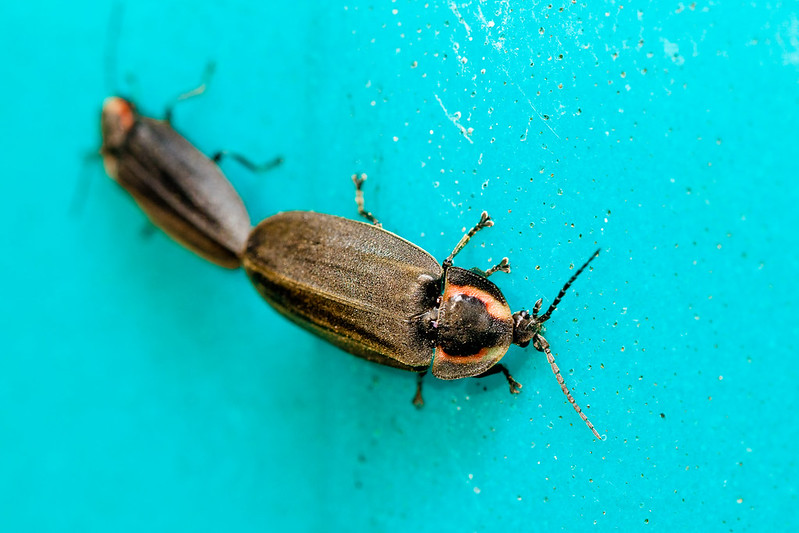


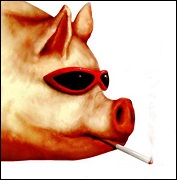










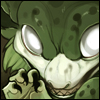






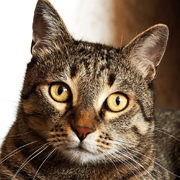








 I CANNOT EJACULATE WITHOUT SEEING NATIVE AMERICANS BRUTALISED!
I CANNOT EJACULATE WITHOUT SEEING NATIVE AMERICANS BRUTALISED!

